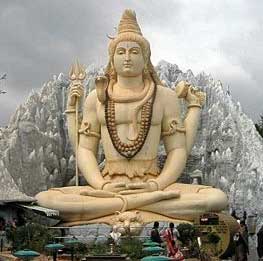Other Links
Shiva the "Great God"
"It is probable that, long before the arrival of the Aryans, the 'great god' ('Mahadeva' or 'Maheshvara') was worshipped in India." Mount Kailas in the Himalayas is the abode of Shiva. "The Ganges came down from the heavens because Shiva bore on the matted locks of his head the forceful impact of her falling torrents."
"He creates and destroys, he sustains the world, he at times obscures by his power of illusion (maya), or offers grace to the suffering world. These are the fivefold activities of Siva, symbolised by the five faces of the god (Pancanana). He sees the past, the present and the future by means of his three eyes (Trilocana). To save the earth, he drank the poison and his throat became dark-blue (Nilakantha). A moon's crescent round or above his central eye (Candrasekhara), clad like an ascetic with a tiger-skin, he holds a trident (Pinaka) in his hand; he rides the bull Nandi. Some of his images represent him as a four-armed person-age, two of the hands holding a battle-axe (khadga) and a deer, the two other hands in poses signifying assurance of safety and liberality; in some other representations, he carries a bow, a thunderbolt, an axe, a skull-capped staff, a drum."
Shiva's family is composed of his wife Uma (Sakti) and their two sons Ganesh and Kartikeya (Subrahmanya). Their respective mounts are the bull, the lion, the mouse and the peacock.
 Unlike Vishnu who
is depicted as dark blue, Sivais white in color,
except for his neck which is dark blue. Images of him in dark blue color
is however the norm. He leads a life of
severe austerities. But in the images we find him tall and well built.
His body is usually besmeared with ashes, denoting his frequent rounds
to the cremation grounds. He has three eyes. The third eye rests between
his eye brows. It is the eye of wisdom, by opening which he destroys our
false selves and our myriad illusions. In contrast to Brahma who
is generally depicted as old, Siva is
usually shown either as a young or middle aged god.
Unlike Vishnu who
is depicted as dark blue, Sivais white in color,
except for his neck which is dark blue. Images of him in dark blue color
is however the norm. He leads a life of
severe austerities. But in the images we find him tall and well built.
His body is usually besmeared with ashes, denoting his frequent rounds
to the cremation grounds. He has three eyes. The third eye rests between
his eye brows. It is the eye of wisdom, by opening which he destroys our
false selves and our myriad illusions. In contrast to Brahma who
is generally depicted as old, Siva is
usually shown either as a young or middle aged god.
Though he is described in the scriptures as god of anger, in the images we generally find him in his cheerful and jovial mood. Sometimes he is depicted with a lot of innocence in his demeanor as Bholenath. He is generally shown sitting cross-legged in a yogic posture, with his eyes closed and deep in meditation. When he is shown with his eyes open, his face expresses love and compassion. The images of Siva evoke in us deep emotions. Those who are inclined to worship god are naturally drawn to him as they hold him in their minds.
Unlike Vishnu, who leads a luxurious life, surrounded by opulence, Siva and his family lead austere lives in simple surroundings. He is a god of utter simplicity, exemplary humility and austerity. A tiger skin and an elephant skin serve as his garments. His long matted hair is normally tied into a knot or left flowing. He has four arms. With one he holds his weapon the trident. With another, he holds Damaru, a small drum. The remaining two are held in abhaya and varada mudras (postures).
The tiger and the elephant skin symbolically signify his ability to control and transform animal nature. The trident represents the three qualities, namely sattva, rajas and tamas. The damru denotes his connection with the primal sound AUM, the creation of alphabets, languages, grammar and music. His long matted hair denotes his spiritual life and his great powers. It is also compared to the night sky. He wears a garland of snakes around his neck. Sometimes we see more snakes: one across his body like a sacred thread and two acting as bracelets around his muscular hands. The snakes symbolically represents his control over desire and sensuality. Sometimes in his ferocious aspects, he is shown wearing a garland of skulls. The crescent moon adorns his hair like a silver diadem. And the Ganges flows from his head down into the world below.